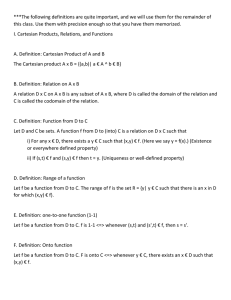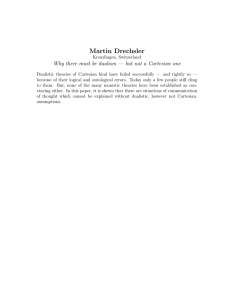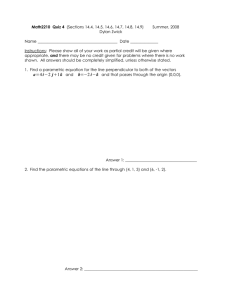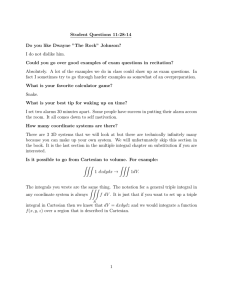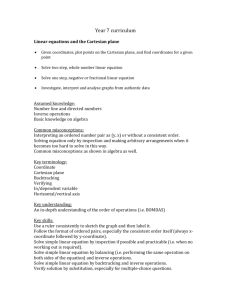On Cartesian trees and range minimum queries Please share
advertisement
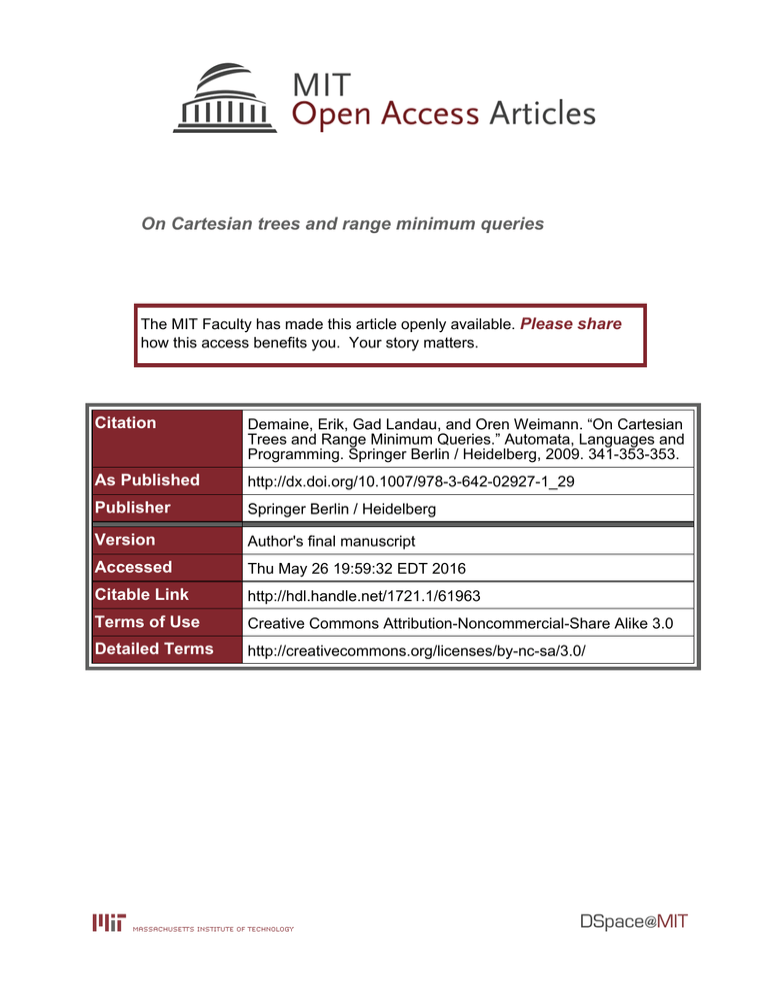
On Cartesian trees and range minimum queries
The MIT Faculty has made this article openly available. Please share
how this access benefits you. Your story matters.
Citation
Demaine, Erik, Gad Landau, and Oren Weimann. “On Cartesian
Trees and Range Minimum Queries.” Automata, Languages and
Programming. Springer Berlin / Heidelberg, 2009. 341-353-353.
As Published
http://dx.doi.org/10.1007/978-3-642-02927-1_29
Publisher
Springer Berlin / Heidelberg
Version
Author's final manuscript
Accessed
Thu May 26 19:59:32 EDT 2016
Citable Link
http://hdl.handle.net/1721.1/61963
Terms of Use
Creative Commons Attribution-Noncommercial-Share Alike 3.0
Detailed Terms
http://creativecommons.org/licenses/by-nc-sa/3.0/
On Cartesian Trees and
Range Minimum Queries
Erik D. Demaine?1 Gad M. Landau??2,3 and Oren Weimann∗1
1
3
MIT Computer Science and Artificial Intelligence Laboratory, Cambridge, MA,
USA. {edemaine,oweimann}@mit.edu
2
Department of Computer Science, University of Haifa, Haifa, Israeal
Department of Computer and Information Science, Polytechnic Institute of NYU.
landau@cs.haifa.ac.il
Abstract.
We present new results on Cartesian trees with applications in range
minimum queries and bottleneck edge queries. We introduce a cacheoblivious Cartesian tree for solving the range minimum query problem,
a Cartesian tree of a tree for the bottleneck edge query problem on trees
and undirected graphs, and a proof that no Cartesian tree exists for the
two-dimensional version of the range minimum query problem.
1
Introduction
In the Range Minimum Query (RMQ) problem, we wish to preprocess an array
A of n numbers for subsequent queries asking for min{A[i], . . . , A[j]}. In the twodimensional version of RMQ, an n×n matrix is preprocessed and the queries ask
for the minimum element in a given rectangle. The Bottleneck Edge Query (BEQ)
problem further generalizes RMQ to graphs. In this problem, we preprocess a
graph for subsequent queries asking for the maximum amount of flow that can
be routed between some vertices u and v along any single path. The capacity of
a path is captured by its edge with minimal capacity (weight). Thus, RMQ can
be seen as a special case of BEQ on line-like graphs.
In all solutions to the RMQ problem the Cartesian tree plays a central role.
Given an array A of n numbers its Cartesian tree is defined as follows: The root
of the Cartesian tree is A[i] = min{A[1], . . . , A[n]}, its left subtree is computed
recursively on A[1], . . . , A[i − 1] and its right subtree on A[i + 1], . . . , A[n]. In this
paper we present new results on Cartesian trees with applications in RMQ and
BEQ. We introduce a cache-oblivious version of the Cartesian tree that leads to
an optimal cache-oblivious RMQ solution. We then give a natural generalization
of the Cartesian tree from arrays to trees and show how it can be used for
solving BEQ on undirected graphs and on trees. Finally, we show that there is
no two-dimensional generalization of a Cartesian tree.
?
??
Supported in part by the Center for Massive Data Algorithmics (MADALGO), a
center of the Danish National Research Foundation.
Supported in part by the Israel Science Foundation grant 35/05, the Israel-Korea
Scientific Research Cooperation and Yahoo.
Range Minimum Queries and Lowest Common Ancestors. The traditional RMQ solutions rely on the tight connection between RMQ and the Lowest
Common Ancestor (LCA) problem. In LCA, we wish to preprocess a rooted tree
T for subsequent queries asking for the common ancestor of two nodes that is
located farthest from the root. RMQ and LCA were shown by Gabowet al. [18]
to be equivalent in the sense that either one can be reduced in linear time to
the other. An LCA instance can be obtained from an RMQ instance on an array
A by letting T be the Cartesian tree of A that can be constructed in linear
time [18]. It is easy to see that RMQ(i, j) in A translates to LCA(A[i], A[j]) in
A’s Cartesian tree. In the other direction, an RMQ instance A can be obtained
from an LCA instance on a tree T by writing down the depths of the nodes
visited during an Euler tour of T . That is, A is obtained by listing all first and
last node-visitations in a DFS traversal of T that starts from the root. The LCA
of two nodes translates to a range minimum query between the first occurrences
of these nodes in A. An important property of the array A is that the difference
between any two adjacent cells is ±1.
As the classical RMQ and LCA problems are equally hard, it is tempting to
think that this is also the case in the cache-oblivious model, where the complexity
is measured in terms of the number of memory-blocks transferred between cache
and disk (see Section 2 for a description of the cache-oblivious model). Indeed, to
solve RMQ on array A, one could solve LCA on the Cartesian tree of A that can
n
be constructed optimally using O( B
) memory transfers (where B is the blockn
transfer size). An optimal O( B
) cache-oblivious LCA solution follows directly
from [9] after obtaining the Euler tour of the Cartesian tree. However, the best
n
n
cache-oblivious algorithm for obtaining the Euler tour requires Θ( B
logM/B B
)
memory transfers [6] where M is the cache-size. The first result of our paper
n
) memory
is an optimal cache-oblivious RMQ data structure that requires O( B
transfers and gives constant-time queries. This makes RMQ cache-obliviously
easier than LCA (unless the LCA instance is given in Euler tour form).
Bottleneck Edge Queries on Graphs and Trees. Given an edge weighted
graph, the bottleneck edge e between a pair of vertices s, t is defined as follows: If P is the set of all simple paths from s to t then e’s weight is given
by maxp∈P (lightest edge in p). In the BEQ problem, we wish to preprocess a
graph for subsequent bottleneck edge queries. Hu [20] proved that in undirected
graphs bottleneck edges can be obtained by considering only the unique paths
in a maximum spanning tree. This means that BEQ on undirected graphs can
be solved by BEQ on trees. Another reason for the importance of BEQ on trees
is the equivalent online minimum spanning tree verification problem. Given a
spanning tree T of some edge weighted graph G, the problem is to preprocess
T for queries verifying if an edge e ∈ G − T can replace some edge in T and
decrease T ’s weight. It is easy to see that this is equivalent to a bottleneck edge
query between e’s endpoints.
The second result in our paper is a natural generalization of the Cartesian tree
from arrays to trees. We show that a Cartesian tree of a tree can be constructed in
linear time plus the time required to sort the edges-weights. It can then be used to
answer bottleneck edge queries in constant time for trees and undirected graphs.
In the full version of this paper, we show how to maintain this Cartesian tree
and constant-time bottleneck edge queries while leaf insertions and deletions are
performed on the input tree. Insertions and deletions require O(log n) amortized
time and O(log log u) amortized time for integral edge weights bounded by u.
Two-dimensional RMQ. In the two-dimensional version of RMQ, we wish
to preprocess an n × n matrix for subsequent queries asking for the minimum
element in a given rectangle. Amir, Fischer, and Lewenstein [5] conjectured that
it should be possible to show that in two dimensions there is no such nice relation
as the one between RMQs and Cartesian Trees in the one-dimensional case. Our
third result proves this conjecture to be true by proving that the number of
different RMQ matrices is roughly (n2 )!, where two RMQ matrices are different
if their range minimum is in different locations for some rectangular range.
1.1
Relation to Previous Work
Practically all known solutions to the range minimum query (RMQ) problem, its
two-dimensional version (2D-RMQ), and its bottleneck edge version (BEQ) on
trees share the same high-level description. They all partition the problem into
some n/s smaller subproblems of size s each. From each of the small subproblems,
one representative (the minimal element of the subproblem) is chosen and the
problem is solved recursively on the n/s representatives. A similar recursion is
applied on each one of the small subproblems. Besides different choices of s, the
main difference between these solutions is the recursion’s halting conditions that
can take one of the following forms.
(I) keep recursing - the recursive procedure is applied until the subproblem is
of constant size.
(II) handle at query - for small enough s do nothing and handle during querytime.
(III) sort - for small enough s use a linear-space O(s log s)-time solution with
constant query time.
(IV) table-lookup - for roughly logarithmic size s construct a lookup-table for all
possible subproblems.
(V) table-lookup & handle at query - for roughly logarithmic size s construct a
lookup-table. A query to this table will return a fixed number of candidates
to be compared during query-time.
Table 1.1 describes how our solutions (in bold) and the existing solutions
relate to the above four options. We next describe the existing solutions in detail.
RMQ and LCA. As we mentioned before, RMQ can be solved by solving
LCA. Harel and Tarjan [19] were the first to show that the LCA problem can
be optimally solved with linear-time preprocessing and constant-time queries
by relying on word-level parallelism. Their data structure was later simplified
by Schieber and Vishkin [28] but remained rather complicated and impractical.
Berkman and Vishkin [10], and then Bender et al. [9] presented further simplifications and removed the need for word-level parallelism by actually reducing
the LCA problem back to an RMQ problem. This time, the RMQ array has the
property that any two adjacent cells differ by ±1. This property was used in [9,
10, 16] to enable table lookups as we now explain.
It is not hard to see that two arrays that admit the same ±1 vector have
the same location of minimum element for every possible range. Therefore, it is
RMQ
handle at query
sort
table-lookup &
handle at query
2D-RMQ
hnαk (n), nαk (n), ki [3] hn2 αk (n)2 , n2 αk (n)2 , ki [13]
keep recursing
table-lookup
BEQ on trees
hn, n, 1i [19]
hn/B, 1i
hn, n, α(n)i [3]
hn2 , n2 , α2 (n)i [13]
hn log[k] n, n, ki
hn2 log[k] n, n2 , ki [5]
impossible [24]
impossible
impossible [24]
hn2 , n2 , 1i [7]
Table 1. Our results (in bold) and their relation to the existing solutions. We denote a solution by hpreprocessing time, space, query timei and by
hmemory transfers in preprocessing, memory transfers in queryi for a cache-oblivious
solution.
possible to compute a lookup-table P storing the answers to all range minimum
queries of all possible ±1 vectors of length s = 12 log n. Since there are O(s2 )
possible queries, the size of P is O(s2 · 2s ) = o(n). Fischer and Heun [16] recently
presented the first optimal RMQ solution that makes no use of LCA algorithms
or the ±1 property. Their solution uses the Cartesian tree but in a different
manner. It uses the fact that the number of different 4 RMQ arrays is equal to
the number
Cartesian trees and thus to the Catalan number which
of possible
s
2s
1
= O( s41.5 ). This means that if we pick s = 41 log n then again the
is s+1
s
s
lookup-table P requires only O(s2 · s41.5 ) = O(n) space.
BEQ. On directed edge weighted graphs, the BEQ problem has been studied
in its offline version, where we need to determine the bottleneck edge for every
pair of vertices. Pollack [27] introduced the problem and showed how to solve it
in O(n3 ) time. Vassilevska, Williams, and Yuster [31] gave an O(n2+ω/3 )-time
algorithm, where ω is the exponent of matrix multiplication over a ring. This
was recently improved by Duan and Pettie [14] to O(n(3+ω)/2 ). For the case of
vertex weighted graphs, Shapira et al. [30] gave an O(n2.575 )-time algorithm.
On trees, the BEQ problem was studied when the tree T is a spanning tree of
some graph and a bottleneck edge query verifies if an edge e 6∈ T can replace some
edge in T and decrease T ’s weight. A celebrated result of Komlós [23] is a lineartime algorithm that verifies all edges in G. The idea of progressively improving an
approximately minimum solution T is the basis of all recent minimum spanning
tree algorithms [12, 21, 25, 26]. Alon and Schieber [3] show that after an almost
linear O(n · αk (n)) preprocessing time and space bottleneck edge queries can
be done in constant time for any fixed k. Here, αk (n) is the inverse of the k th
row of Ackerman’s function5 : αk (n) = 1 + αk (αk−1 (n)) so that α1 (n) = n/2,
4
5
Two RMQ arrays are different if their range minimum is in different locations for
some range.
We follow Seidel [29]. The function α(·) is usually defined slightly differently, but all
variants are equivalent up to an additive constant.
α2 (n) = log n, α3 (n) = log∗ n, α4 (n) = log∗∗ n and so on6 . Pettie [24] gave a
tight lower bound of Ω(n · αk (n)) preprocessing time required for O(k) query
time. Alon and Schieber further prove that if optimal O(n) preprocessing space
is required, it can be done with α(n) query time.
If the edge-weights are already sorted, our solution is better than the one
of [3]. For arbitrary unsorted edge-weights, we can improve [3] in terms of space
complexity. Namely, we give a linear space and constant query time solution that
requires O(n log[k] n) preprocessing time for any fixed k, where log[k] n denotes
the iterated application of k logarithms.
2D-RMQ. For the two-dimensional version of RMQ on an n×n matrix, Gabow,
Bentley and Tarjan [18] suggested an O(n2 log n) preprocessing time and space
and O(log n) query time solution. This was improved by Chazelle and Rosenberg [13] to O(n2 · αk (n)2 ) preprocessing time and space and O(1) query time
for any fixed k. Chazelle and Rosenberg further prove that if optimal O(n2 )
preprocessing space is required, it can be done with α2 (n) query time. Amir,
Fischer, and Lewenstein [5] showed that O(n2 ) space and constant query time
can be obtained by allowing O(n2 log[k] n) preprocessing time for any fixed k.
Amir, Fischer, and Lewenstein also conjectured that in two dimensions there
is no such nice relation as the one between the number of different RMQs and
the number of different Cartesian Trees in the one-dimensional case. We prove
this conjecture to be true thereby showing that O(n2 ) preprocessing time and
constant query time can not be achieved using the existing methods for onedimensional RMQ. Indeed, shortly after we proved this, Atallah and Yuan (in
a yet unpublished result [7]) discovered a new optimal RMQ solution that does
not use Cartesian trees and extends to two dimensions.
2
A Cache-Oblivious Cartesian Tree
While modern memory systems consist of several levels of cache, main memory,
and disk, the traditional RAM model of computation assumes a flat memory with
uniform access time. The I/O-model, developed by Aggarwal and Vitter [2], is
a two-level memory model designed to account for the large difference in the
access times of cache and disks. In this model, the disk is partitioned into blocks
of B elements each, and accessing one element on disk copies its entire block
to cache. The cache can store up to M/B blocks, for a total size of M . The
efficiency of an algorithm is captured by the number of block transfers it makes
between the disk and cache.
The cache-oblivious model, introduced by Frigo et al. [17], extends the I/Omodel to a multi-level memory model by a simple measure: the algorithm is not
allowed to know the value of B and M . More precisely, a cache-oblivious algorithm is an algorithm formulated in the standard RAM model, but analyzed in
the I/O-model, with an analysis valid for any value of B and M and between
6
log∗∗ n is the number of times log∗ function is applied to n to produce a constant,
k times
z }| {
αk (n) = log∗ ∗ · · · ∗ n and the inverse Ackerman function α(n) is the smallest k such
that αk (n) is a constant.
any two adjacent memory-levels. When the cache is full, a cache-oblivious algorithm can assume that the ideal block in cache is selected for replacement based
on the future characteristics of the algorithm, that is, an optimal offline paging
strategy is assumed. This assumption is fair as most memory systems (such as
LRU and FIFO) approximate the omniscient strategy within a constant factor.
See [17] for full details on the cache-oblivious model.
It is easy to see that the number of memory transfers needed to read or write
n
n contiguous elements from disk is scan(n) = Θ( B
), even if B is unknown. A
stack that is implemented using a doubling array can support n push\pop operations in scan(n) memory transfers. This is because the optimal paging strategy
can always keep the last block of the array (accessed by both push and pop)
in cache. Other optimal cache-oblivious data structures have been recently proposed, including priority queues [6], B-trees [8], string dictionaries [11], kd-trees
and Range trees [1]. An important result of Frigo et al. shows that the number
n
n
of memory transfers needed to sort n elements is sort(n) = Θ( B
logM/B B
).
For the RMQ problem on array A, the Cartesian tree of A can be constructed
optimally using scan(n) memory transfers by implementing the following construction of [18]. Let Ci be the Cartesian tree of A[1, . . . , i]. To build Ci+1 , we
notice that node A[i + 1] will belong to the rightmost path of Ci+1 , so we climb
up the rightmost path of Ci until we find the position where A[i+1] belongs. It is
easy to see that every “climbed” node will be removed from the rightmost path
and so the total time complexity is O(n). A cache-oblivious stack can therefore
maintain the current rightmost path and the construction outputs the nodes of
the Cartesian tree in postorder. However, in order to use an LCA data structure
on the Cartesian tree we need an Euler tour order and not a postorder. The
most efficient way to obtain an Euler tour [6] requires sort(n) memory transfers.
Therefore sort(n) was until now the upper bound for cache-oblivious RMQ. In
this section we prove the following result.
Theorem 1. An optimal RMQ data structure with constant query-time can be
constructed using scan(n) memory transfers.
We start by showing a simple constant-time RMQ data structure [9] that
can be constructed using scan(n) log n memory transfers. The idea is to precompute the answers to all range minimum queries whose length is a power
of two. Then, to answer RM Q(i, j) we can find (in constant time) two such
overlapping ranges that exactly cover the interval [i, j], and return the minimum between them. We therefore wish to construct arrays M0 , M1 , . . . , Mlog n
where Mj [i] = min{A[i], . . . , A[i + 2j − 1]} for every i = 1, 2, . . . , n. M0 is simply A. For j > 0, we construct Mj by doing two parallel scans of Mj−1 using scan(n) memory transfers (we assume M ≥ 2B). The first scan starts at
Mj−1 [1] and the second at Mj−1 [1 + 2j−1 ]. During the parallel scan we set
Mj [i] = min{Mj−1 [i], Mj−1 [i + 2j−1 ]} for every i = 1, 2, . . . , n.
After describing this scan(n) log n solution, we can now describe the scan(n)
solution. Consider the partition of A into disjoint intervals (blocks) of s = 41 log n
consecutive elements. The representative of every block is the minimal element
in this block. Clearly, using scan(n) memory transfers we can compute an array
of the n/s representatives. We use the RMQ data structure above on the representatives array. This data structure is constructed with scan(n/s) log(n/s) =
scan(n) memory transfers and is used to handle queries whose range spans more
than one block. The additional in-block prefix and suffix of such queries can be
accounted for by pre-computing RM Q(i, j) of every block prefix or suffix. This
again can easily be done using scan(n) memory transfers.
We are therefore left only with the problem of answering queries whose range
is entirely inside one block. Recall that two RMQ arrays are different if their
range minima are in different locations for some range. Fischer and Heun [16]
observed that the number of different blocks is equal to the number of possible
Cartesian trees of s elements and thus to the s’th Catalan number which is
o(4s ). For each such unique block type, the number of possible in-block ranges
[i, j] is O(s2 ). We can therefore construct an s2 × 4s lookup-table P of size
O(s2 · 4s ) = o(n) that stores the locations of all range minimum queries for all
possible blocks.
It remains to show how to index table P (i.e. how to identify the type of
every block in the partition of A) and how to construct P using scan(n) memory
transfers. We begin with the former. The most naive way to calculate the block
types would be to actually construct the Cartesian tree of each block in A,
and then use an inverse enumeration of binary trees [22] to compute its type.
This approach however can not be implemented via scans. Instead, consider the
Cartesian tree signature of a block as the sequence `1 `2 · · · `s where 0 ≤ `i < s is
the number of nodes removed from the rightmost path of the block’s Cartesian
tree when inserting the i’th element. For example, the block “3421” has signature
“0021”.
Pi
Notice that for every signature `1 `2 · · · `s we have k=1 `k < i for every 1 ≤
i ≤ s. This is because one cannot remove more elements from the rightmost path
than one has inserted before. Fischer and Heun used this property to identify
each signature by a special sum of the so-called Ballot Numbers [22]. We suggest
a simpler and cache-oblivious way of computing a unique number f (`1 `2 · · · `s ) ∈
{0, 1, . . . , 4s − 1} for every signature `1 `2 · · · `s . The binary representation of this
number is simply
`1
`2
`s
z }| { z }| {
z }| {
11 · · · 1 0 11 · · · 1 0 · · · 0 11 · · · 1 0.
Ps
Clearly, each signature is assigned a different number and since
i=1 `i < s
this number is between 0 and 22s − 1 as its binary representation is of length
at most 2s. Notice that some binary strings of length at most 2s (for example,
strings starting with 1 or with 011) are not really an f (`1 `2 · · · `s ) of a valid
signature `1 `2 · · · `s (i.e. f is not surjective). Using a stack, in one scan of A we
can compute the signatures of all blocks in the partition of A in the order they
appear. We refer to the sequence of signatures as S(A), this sequence has n/s
signatures each of length s. In a single scan of S(A) we can compute f (`1 `2 · · · `s )
for all signatures in S(A) thus solving our problem of indexing P .
We are left only with showing how to construct P using scan(n) memory
transfers. In the non cache-oblivious world (that Fischer and Heun consider)
this is easy. We really only need to compute the entries in P that correspond to
blocks that actually appear in the partition of A. During a scan of S(A), for each
signature `1 `2 · · · `s we check if column f (`1 `2 · · · `s ) in P was already computed
(this requires n/s such checks). If not, we can compute all O(s2 ) range minima of
the block trivially in O(s) time per range. In the cache-oblivious model however,
each of the n/s checks might bring a new block to cache. If s < B then this
incurs more than scan(n) memory transfers.
Therefore, for an optimal cache-oblivious performance, we must construct
the entire table P and not only the columns that correspond to signatures in
S(A). Instead of computing P ’s entries for all possible RMQ arrays of length s
we compute P ’s entries for all possible binary strings of length 2s. Consider an
RMQ block A0 of length s with signature `1 `2 · · · `s . In Fig. 1 we give a simple
procedure that computes RM Q(i, j) in A0 for any 1 ≤ i ≤ j ≤ s by a single
scan of f 0 = f (`1 `2 · · · `s ). Again, we note that for binary strings f 0 that are not
really an f (`1 `2 · · · `s ) of a valid signature `1 `2 · · · `s this procedure computes
“garbage” that will never be queried.
1:
2:
3:
4:
5:
6:
7:
initialize min ← i and x ← 0
scan f 0 until the ith 0
for j 0 = i + 1, . . . , j
continue scanning f 0 until the next 0
set x ← x + 1− the number of 1’s read between the last two 0’s
if x ≤ 0 set min ← j 0 and x ← 0
return min as the location of RM Q(i, j)
Fig. 1. Pseudocode for computing RM Q(i, j) for some 1 ≤ i ≤ j ≤ s using one scan
of the binary string f 0 = f (`1 `2 · · · `s ) of some signature `1 `2 · · · `s .
In order to use the procedure of Fig. 1 on all possible signatures, we construct a sequence S of all binary strings of length 2s in lexicographic order.
S is the concatenation of 4s substrings each of length 2s, and S can be written using scan(2s · 4s ) = o(scan(n)) memory transfers. For correctness of the
above procedure, a parallel scan of S can be used to apply the procedure
only on those substrings that have exactly s 0’s. We can thus compute each
row of P using scan(2s · 4s ) memory transfers and the entire table P using
s2 · scan(2s · 4s ) = o(scan(n)) memory transfers7 . This concludes the description of our cache-oblivious RMQ data structure that can be constructed using a
constant number of scans.
3
A Cartesian Tree of a Tree
In this section we address bottleneck edge queries on trees. We introduce the
Cartesian tree of a tree and show how to construct it in O(n) time plus the
time required to sort the edge weights. Recall that an LCA data structure on
the standard Cartesian tree can be constructed in linear time to answer range
minimum queries in constant time. Similarly, an LCA data structure on our
7
Since the (unknown) B can be greater than the length of S we don’t really scan S
for s2 times. Instead, we scan once a sequence of s copies of S.
Cartesian tree can be constructed in linear time to answer bottleneck edge queries
in constant time for trees.
Given an edge weighted input tree T , we define its Cartesian tree C as follows.
The root r of C represents the edge e = (u, v) of T with minimum weight (ties
are resolved arbitrarily). The two children of r correspond to the two connected
component of T − e: the left child is the recursively constructed Cartesian tree
of the connected component containing u, and the right child is the recursive
construction for v. Notice that C’s internal nodes correspond to T ’s edges and
C’s leaves correspond to T ’s vertices.
Theorem 2. The Cartesian tree of a weighted input tree with n edges can be
constructed in O(n) time plus the time required to sort the weights.
Decremental connectivity in trees. The proof of Theorem 2 uses a data
structure by Alstrup and Spork [4] for decremental connectivity in trees. This
data structure maintains a forest subject to two operations: deleting an edge in
O(1) amortized time, and testing whether two vertices u and v are in the same
connected component in O(1) worst-case time.
The data structure is based on a micro-macro decomposition of the input
tree T . The set of nodes of T is partitioned into disjoint subsets where each
subset induces a connected component of T called the micro tree. The division is
constructed such that each micro tree is of size Θ(lg n) and at most two nodes in
a micro tree (the boundary nodes) are incident with nodes in other micro trees.
The nodes of the macro tree are exactly the boundary nodes and it contains an
edge between two nodes iff T has a path between the two nodes which does not
contain any other boundary nodes.
It is easy to see that deletions and connectivity queries can be performed by
a constant number of deletions and connectivity queries on the micro and macro
trees. The macro tree can afford to use a standard O(lg n) amortized solution [15],
which explicitly relabels all nodes in the smaller of the two components resulting
from a deletion. The micro trees use simple word-level parallelism to manipulate
the logarithmic-size subtrees.
Although not explicitly stated in [4], the data structure can in fact maintain a
canonical name (record) for each connected component, and can support finding
the canonical name of the connected component containing a given vertex in O(1)
worst-case time. The macro structure explicitly maintains such names, and the
existing tools in the micro structure can find the highest node (common ancestor)
of the connected component of a vertex, which serves as a name. This slight
modification enables us to store a constant amount of additional information
with each connected component, and find that information given just a vertex
in the component.
Proof of Theorem 2. We next describe the algorithm for constructing the
Cartesian tree C of an input tree T . The algorithm essentially bounces around
T , considering the edges in increasing weight order, and uses the decremental
connectivity data structure on T to pick up where it left off in each component.
Precisely:
1. initialize the decremental connectivity structure on T . Each connected component has two fields: “parent” and “side”.
2. set the “parent” of the single connected component to null.
3. sort the edge weights.
4. for each edge e = (u, v) in increasing order by weight:
(a) make a vertex w in C corresponding to e, whose parent is the “parent”
of e’s connected component in the forest, and who is the left or right
child of that parent according to the “side” of that component.
(b) delete edge e from the forest.
(c) find the connected component containing u and set its “parent” to w
and its “side” to “left”.
(d) find the connected component containing v and set its “parent” to w
and its “side” to “right”.
After sorting the edge weights, this algorithm does O(n) work plus the work
spent for O(n) operations in the decremental connectivity data structure, for a
total of O(n) time.
Optimality. It is not hard to see that sorting the edge weights is unavoidable
when computing a Cartesian tree of a tree. Consider a tree T with a root and
n children, where the ith child edge has weight A[i]. Then the Cartesian tree
consists of a path, with weights equal to the array A in increasing order. Thus
we obtain a linear-time reduction from sorting to computing a Cartesian tree.
If you prefer to compute Cartesian trees only of bounded-degree trees, you can
expand the root vertex into a path of n vertices, and put on every edge on the
path a weight larger than max{A[1], . . . , A[n]}.
BEQ on Trees. For the BEQ problem on a tree T , if the edge weights are
integers or are already sorted, our solution is optimal. We now show that for arbitrary unsorted edge-weights we can use our Cartesian tree to get an O(n)-space
O(1)-query BEQ solution for trees that requires O(n lg[k] n) preprocessing time
for any fixed k (recall lg[k] n denotes the iterated application of k logarithms).
We present an O(n lg lg n) preprocessing time algorithm, O(n lg[k] n) is achieved
by recursively applying our solution for k times.
Consider the micro-macro decomposition of T described above. Recall that
each micro tree is of size Θ(lg n). We can therefore sort the edges in each micro
tree in Θ(lg n lg lg n) time and construct the Θ( lgnn ) Cartesian trees of all micro
trees in a total of Θ(n lg lg n) time. This allows us to solve BEQ within a micro
tree in constant time. To handle BEQ between vertices in different micro trees,
we construct the Cartesian tree of the macro tree. Recall that the macro tree
contains Θ( lgnn ) nodes (all boundary nodes). The edges of the macro tree are
of two types: edges between boundary nodes of different micro trees, and edges
between boundary nodes of the same micro tree. For the former, we set their
weights according to their weights in T . For the latter, we set the weight of an
edge between two boundary nodes u, v of the same micro tree to be equal to
BEQ(u, v) in this micro tree. BEQ(u, v) is computed in constant time from the
Cartesian tree of the appropriate micro tree. Thus, we can compute all edge
weights of the macro tree and then sort them in O( lgnn lg lgnn ) = O(n) time and
construct the Cartesian tree of the macro tree.
To conclude, we notice that any bottleneck edge query on T can be solved
by a constant number of bottleneck edge queries on the Cartesian tree of the
macro tree and on two more Cartesian trees of micro trees.
In the full version of this paper, we show how to maintain the Cartesian tree
along with its LCA data structure on a dynamic input tree.
Theorem 3. We can maintain constant-time bottleneck edge queries on a tree
while leaf insertions/deletions are performed in O(lg n) amortized time and in
O(lg lg u) amortized time when the edge-weights are integers bounded by u.
4
Two-Dimensional RMQ
Apart from the new result of [7], the known solutions [9, 10, 16, 19, 28] to the standard one dimensional RMQ problem make use of the Cartesian tree. Whether
as a tool for reducing the problem to LCA or in order to enable table-lookups
for all different Cartesian trees. Amir, Fischer, and Lewenstein [5] conjectured
that no Cartesian tree equivalent exists in the two-dimensional version of RMQ
denoted 2D-RMQ. In the full version of this paper we prove this conjecture to
be true.
n/4 Theorem 4. The number of different8 2D-RMQ n × n matrices is Ω n4 !
References
1. P.K. Agarwal, L. Arge, A. Danner, and B. Holland-Minkley. Cache-oblivious data
structures for orthogonal range searching. In Proceedings of the 19th annual ACM
Symposium on Computational Geometry (SCG), pages 237–245, 2003.
2. A. Aggarwal and J. S. Vitter. The input/output complexity of sorting and related
problems. Communications of the ACM, 31(9):1116–1127, 1988.
3. N. Alon and B. Schieber. Optimal preprocessing for answering on-line product
queries. Technical report, TR-71/87, Institute of Computer Science, Tel Aviv
University, 1987.
4. S. Alstrup and M. Spork. Optimal on-line decremental connectivity in trees. Information Processing Letters, 64(4):161–164, 1997.
5. A. Amir, J. Fischer, and M. Lewenstein. Two-dimensional range minimum queries.
In Proceedings of the 18th annual symposium on Combinatorial Pattern Matching
(CPM), pages 286–294, 2007.
6. L. Arge, M.A. Bender, E.D. Demaine, B. Holland-Minkley, and J.I. Munro. An
optimal cache-oblivious priority queue and its application to graph algorithms.
SIAM Journal on Computing, 36(6):1672–1695, 2007.
7. M.J. Atallah and H. Yuan. Data structures for range minimum queries in multidimensional arrays. Manuscript, 2009.
8. M.A. Bender, E.D. Demaine, and M. Farach-colton. Cache-oblivious B-trees. In
SIAM Journal on Computing, pages 399–409, 2000.
9. M.A. Bender, M. Farach-Colton, G. Pemmasani, S. Skiena, and P. Sumazin. Lowest
common ancestors in trees and directed acyclic graphs. Journal of Algorithms,
57(2):75–94, 2005.
8
Two matrices are different if their range minima are in different locations for some
rectangular range.
10. O. Berkman and U. Vishkin. Recursive star-tree parallel data structure. SIAM
Journal on Computing, 22(2):221–242, 1993.
11. G.S. Brodal and R. Fagerberg. Cache-oblivious string dictionaries. In Proceedings
of the 17th annual Symp. On Discrete Algorithms (SODA), pages 581–590, 2006.
12. B. Chazelle. A minimum spanning tree algorithm with inverse-ackermann type
complexity. Journal of the ACM, 47(6):1028–1047, 2000.
13. B. Chazelle and B. Rosenberg. Computing partial sums in multidimensional arrays.
In Proceedings of the 5th annual ACM Symposium on Computational Geometry
(SCG), pages 131–139, 1989.
14. R. Duan and S. Pettie. Fast algorithms for (max,min)-matrix multiplication and
bottleneck shortest paths. In Proceedings of the 20th annual Symposium On Discrete Algorithms (SODA), 2009.
15. S. Even and Y. Shiloach. An on-line edge deletion problem. Journal of the ACM,
28:1–4, 1981.
16. J. Fischer and V. Heun. Theoretical and practical improvements on the RMQproblem, with applications to LCA and LCE. In Proceedings of the 17th symposium
on Combinatorial Pattern Matching (CPM), pages 36–48, 2006.
17. M. Frigo, C.E. Leiserson, H. Prokop, and S. Ramachandran. Cache-oblivious algorithms. In Proceedings of the 40th symposium on Foundations Of Computer
Science (FOCS), pages 285–298, 1999.
18. H. Gabow, J.L. Bentley, and R.E Tarjan. Scaling and related techniques for geometry problems. In Proceedings of the 16th annual ACM Symposium on Theory
Of Computing (STOC), pages 135–143, 1984.
19. D. Harel and R.E. Tarjan. Fast algorithms for finding nearest common ancestors.
SIAM Journal on Computing, 13(2):338–355, 1984.
20. T. C. Hu. The maximum capacity route problem. Operations Research, 9(6):898–
900, 1961.
21. D.R. Karger, P.N. Klein, and R.E. Tarjan. A randomized linear-time algorithm
for finding minimum spanning trees. Journal of the ACM, 42:321–329, 1995.
22. D.E. Knuth. The Art of Computer Programming Volume 4 Fascicle 4: Generating
All Trees; History of Combinatorial Generation. Addison-Wesley, 2006.
23. J. Komlós. Linear verification for spanning trees. Combinatorica, 5(1):57–65, 1985.
24. S. Pettie. An inverse-ackermann style lower bound for the online minimum spanning tree. In Proceedings of the 43rd symposium on Foundations Of Computer
Science (FOCS), pages 155–163, 2002.
25. S. Pettie and V. Ramachandran. Minimizing randomness in minimum spanning
tree, parallel connectivity and set maxima algorithms. In Proceedings of the 13th
annual Symposium On Discrete Algorithms (SODA), pages 713–722, 2002.
26. S. Pettie and V. Ramachandran. An optimal minimum spanning tree algorithm.
Journal of the ACM, 49(1):16–34, 2002.
27. M. Pollack. The maximum capacity through a network. Operations Research,
8(5):733–736, 1960.
28. B. Schieber and U. Vishkin. On finding lowest common ancestors: Simplification
and parallelization. SIAM Journal on Computing, 17:1253–1262, 1988.
29. R. Seidel. Understanding the inverse ackermann function. PDF presenttion. Available at http://cgi.di.uoa.gr/∼ewcg06/invited/Seidel.pdf.
30. A. Shapira, R. Yuster, and U. Zwick. All-pairs bottleneck paths in vertex weighted
graphs. In Proceedings of the 18th annual Symposium On Discrete Algorithms
(SODA), pages 978–985, 2007.
31. V. Vassilevska, R. Williams, and R. Yuster. All-pairs bottleneck paths for general
graphs in truly sub-cubic time. In Proceedings of the 39th annual ACM Symposium
on Theory Of Computing (STOC), pages 585–589, 2007.
